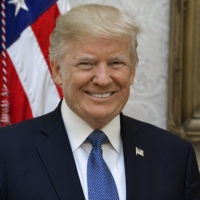President Donald Trump said on Thursday he had instructed US trade officials to consider $100 billion in additional tariffs on China, extending an already hot trade confrontation between the world’s top trading nations.

The additional tariffs were being considered after China responded to earlier US trade actions that included $50 billion of tariffs on Chinese goods.
“In light of China’s unfair retaliation, I have instructed the USTR to consider whether $100 billion of additional tariffs would be appropriate under section 301 and, if so, to identify the products upon which to impose such tariffs,” Trump stated in a Townhall.
The US Trade Representative had determined that China "has repeatedly engaged in practices to unfairly obtain America's intellectual property," he added.
Trump's after-market-hours comments spurred a sharp sell-off in US equity futures markets. The S&P 500 e-mini futures traded down 1.3 per cent, while similar moves were reflected in Dow and Nasdaq futures. In currency markets, the US dollar fell against the Japanese yen, down 0.30 per cent to 107.06 yen.
Earlier this week, the Trump administration proposed 25-per cent tariffs on some 1,300 Chinese industrial and other products, mainly high-tech products.
"Rather than remedy its misconduct, China has chosen to harm our farmers and manufacturers," Trump said.
White House officials had earlier suggested that talks with the Chinese could help resolve trade issues between the two countries. China ran a $375 billion surplus in merchandise trade with the United States in 2017. Trump has demanded that China cut the trade gap by $100 billion.
While the Trump administration was willing to negotiate with China, US officials said, no formal negotiating sessions had yet been set.
They said the US tariffs were aimed at forcing changes to Chinese government policies designed to transfer US intellectual property to Chinese companies.
A 'Section 301’ investigation by the United States Trade Representative, which authorised the tariffs, alleges China has systematically sought to misappropriate US intellectual property through joint venture requirements that often cannot be negotiated without technology transfers. China, however, denies this.
US trade deficit rose for the sixth straight month in February, reaching the highest level since October 2008 and defying President Donald Trump's efforts to rebalance America's lopsided trade with the rest of the world.
The Commerce Department said on Thursday that the trade gap — the difference between what America sells and what it buys in foreign markets — widened to $57.6 billion in February from $56.7 billion in January. Exports of goods and services hit a record $204.4 billion; imports set a record $262 billion.
US trade dispute with China has rattled global financial markets and raised fears among US farmers and businesses that depend on access to the Chinese market. The trade deficit in goods with China narrowed in February to $29.3 billion from $36 billion in January.
The United States ran a $77-billion deficit in the trade of goods in February, the highest level since July 2008. That was partially offset by a $19.4 billion surplus in services such as education and banking, lowest since December 2012. The services surplus was dragged down $1 billion in payments for broadcast rights for the 2018 Pyeongchang Winter Olympics, which count as a services import.
President Donald Trump views trade deficits as a sign of economic weakness and as the result of bad trade agreements and unfair practices by America's trading partners. Most economists, however, attribute this to the fact that the United States consistently spends more than it produces.
The trade gap has continued to rise since Trump entered the White House partly because the US economy is strong and American consumers have an appetite for imported products and the confidence and financial wherewithal to buy them.
The tit-for-tat tariffs raise the possibility of the two countries spiralling into a trade war that could undermine global growth.
 The additional tariffs were being considered after China responded to earlier US trade actions that included $50 billion of tariffs on Chinese goods.
The additional tariffs were being considered after China responded to earlier US trade actions that included $50 billion of tariffs on Chinese goods.





















